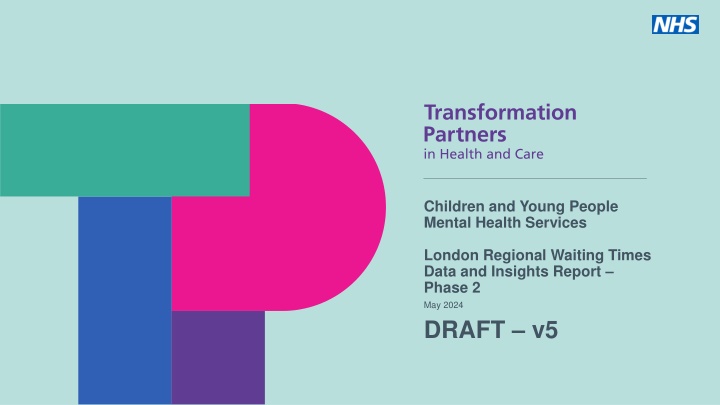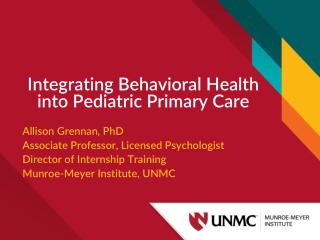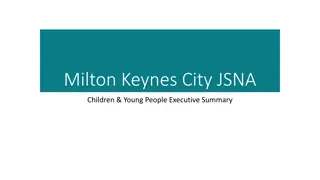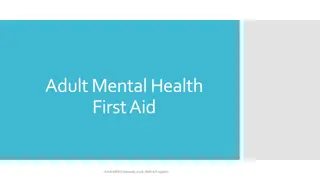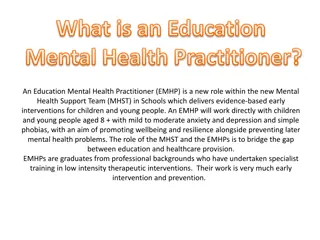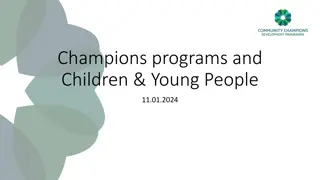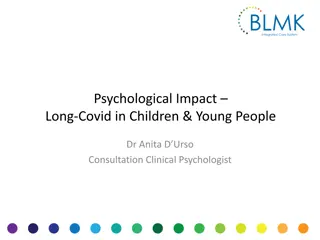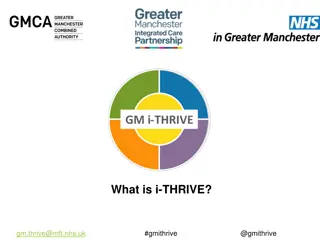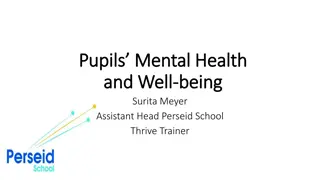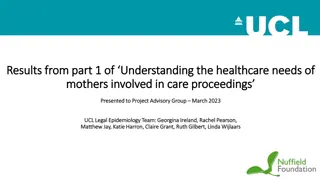Children & Young People Mental Health Services London Insights Report
Investigating waiting times for Children & Young People in London, analyzing data from Mental Health Services Data Set, revealing factors contributing to longer waits like triage approaches, and proposing actions for service improvement.
Download Presentation

Please find below an Image/Link to download the presentation.
The content on the website is provided AS IS for your information and personal use only. It may not be sold, licensed, or shared on other websites without obtaining consent from the author.If you encounter any issues during the download, it is possible that the publisher has removed the file from their server.
You are allowed to download the files provided on this website for personal or commercial use, subject to the condition that they are used lawfully. All files are the property of their respective owners.
The content on the website is provided AS IS for your information and personal use only. It may not be sold, licensed, or shared on other websites without obtaining consent from the author.
E N D
Presentation Transcript
Children and Young People Mental Health Services London Regional Waiting Times Data and Insights Report Phase 2 May 2024 DRAFT v5
Contents 3 Executive summary 4 Project background 5 Project methodology 10 Key findings 13 Data analysis 23 Engagement findings 27 Recommendations 30 Appendices
Executive summary Following acceptance of Children and Young People s Mental Health (CYPMH) as a key priority for the London Mental Health Board (LMHB), Transformation Partners in Health and Care (TPHC) was previously commissioned to deliver an insights report investigating the state of mental health services waiting times for Children and Young People (CYP) in London. Pseudonymised data from the Mental Health Services Data Set (MHSDS) was provided in this earlier phase by NHS England and covered individuals aged 0-18 years. causes of variation; undertake a discovery process to assess local understanding of factors behind waiting times and the capability of existing and proposed data. Findings from these activities are presented in the current report. The maturity of analytics varies across ICBs and providers. Many are in early stages of establishing operational tools, although some providers have live waiting times dashboards. Several factors were identified as contributing to longer waiting times, including triage approaches. Patients with higher acute risk are prioritised, which is likely a factor behind longer waits where there is a less acute risk, e.g. with some neurodevelopmental services. Many ICB and provider stakeholders talked about bringing down the longest waiting times, with several targeting neurodevelopmental pathways. Stigma, cultural understanding of mental health, language barriers, and lack of trust in healthcare professionals may also affect how CYP and families from racialised communities present symptoms/behaviours and consequently assessments of risk and prioritisation when triaging. Between 2021 and 2023, the median initial waiting time for Black males has decreased from ~4-5x the median for the full 0-18yrs cohort to just under 2x. Our data suggests inequalities across ethnicities decreased through 2022 and into 2023 and may be partially explained by differences in the service types and providers to which different ethnicities tend to be referred. The longer waiting times for males compared to females is consistent and largely unexplained by our data. The report revealed significant variation in waiting times across gender, ethnicity and providers as well as issues pertaining to data quality. Groups with longer median initial waiting times included, Black and Mixed/Other CYP, males and notably Black males. The latter had an initial median waiting time of 20 days, which is over 3x the median for all 0- 18yr old London referrals. 18.7% of all referrals had no ethnicity recorded and median waiting times for given Integrated Care Boards (ICBs) ranged from 3 (NEL) to 25 days (SEL). The quality of data submitted to the MHSDS appears to be a factor in variation between providers. Several stakeholders noted significant differences between the MHSDS data and their provider data. Data quality and variation between providers may be worsened by uncertainty in definitions of care contacts and clock stops. Additionally, high rates of unreported ethnicity (18.7%) are present across many service types. The most notable contributor to low ethnicity capture rates is Single Point of Access (29% unreported ethnicity rate). This report proposes explanations for the findings in our initial report on CYPMH waiting times based on the available data. For these findings to lead to CYPMH service improvement, we suggest the following actions: 1) share knowledge and best- practice; 2) improve MHSDS data quality; 3) develop and roll-out local analysis/reporting tools for service providers; 4) triangulate qualitative and quantitative research on factors driving waiting times. The LMHB determined that additional analysis and research was required to explain these findings and ultimately take action to address inequalities. TPHC Consulting were asked to: perform additional analysis on existing data to better understand the nature of observed inequalities; engage with ICB and provider leads to gain qualitative insight on root 3
Project background Background Following acceptance of two key priorities at the London Mental Health Board (see right), it was agreed that to be effective in regional transformation the focus should be on a smaller number of high priority areas including Children and Young People (CYP) access and early intervention to Mental Health services. Many CYP face long wait times1, with some experiencing inequalities of access, experiences and outcomes. In March 2023, the London Mental Health Board outlined two key priorities for regional mental health transformation and identified four enabler workstreams to support transformation: In November 2023, TPHC delivered an insights report to the London Mental Health Board investigating the state of mental health services waiting times for CYP in London. The report was an outcome of initial insights and analysis work (Phase 1). The Board identified several areas relating to data quality and variation in waiting times meriting further work. TPHC Consulting were asked to support the workstream by: Performing additional analysis using previously collected datasets to better understand the nature of observed waiting time inequalities, including those for Black male CYP in London. 1. Advancing Mental Health Equalities (AMHE) Disseminating the Phase 1 report and its findings to Integrated Care Board (ICB) leads and engaging with them to gain qualitative insight on the root causes of the variation identified. 2. Children and Young People s Mental Health (CYPMH) Undertaking a data inventory and discovery process to assess which of the questions posed by the London Mental Health Board are answerable with the data already available, what data would be needed to answer the remaining questions, and how much effort would be required to gain access. Enablers: Data and insights This work is intended to 1) further explore key areas of variation in waiting times and potential factors explaining these, and 2) provide suggestions for how further work conducted locally could increase our understanding of these factors and lead to interventions that reduce the longest CYPMH waiting times and inequalities across waits. Digital transformation Comms and engagement 1 Big Young People s Survey, Young Minds. Available at: https://www.youngminds.org.uk/support-us/join-the-movement/end-the-wait/ (Accessed: 27/03/24) Workforce 4
Project methodology This section presents an overview of the approaches taken to stakeholder engagement and data collection.
Project approach We took the following approach to deliver the project objectives. Stage Project set-up and discovery Data collection and analysis Stakeholder engagement Report and recommendations Project set-up and discovery Data collection and analysis Stakeholder engagement Report and recommendations Define activities to be completed Identify possible hypotheses for the findings in Phase 1 regarding causal factors Engage with ICB and mental health provider representatives to: o share and take reflections on initial findings; o discuss local work regarding CYPMH waiting times; and o learn about ICB/provider plans or priorities regarding future work on CYPMH waiting times Use insights from stakeholder engagement and data analysis to develop findings that direct targeted work locally and regionally to understand the causal factors behind variation in waiting times Activities Identify stakeholders to engage with during the project Perform exploratory analysis to test the feasibility of these hypotheses, where possible with the available MHSDS data Identify key findings from Phase 1 to explore further, focusing on areas of significant variation and/or potential inequalities Develop recommendations for advancing the understanding of CYPMH waiting times through data 6
Data considered for analysis During Phase 1, we determined that to conduct valuable analysis, we would need to access patient-level NHS datasets. Multiple stakeholders informed us that provider data would be the most reliable and accurate source. However, access to patient-level provider or Mental Health Services Data Set (MHSDS) data was unfortunately not feasible due to constraints on data sharing. We can however interrogate the feasibility of some hypotheses (e.g., whether longer average waiting times for male CYP, as compared to female CYP, are due to a higher proportion of male neurodevelopmental service referrals) and recommend next steps in understanding causal factors. Field of interest? Field name Derived dimension The NHS England London region teamprovided a pseudonymised extract of MHSDS data covering referrals from April 2019 to July 2023. Pseudo Patient Number Counts of referrals Pseudo Patient ReferralID This dataset is a pseudonymised record of the dates and types of all patient referrals, first care contacts and second care contacts for mental health services across the London region. The dataset also contains accompanying information on each patient s personal characteristics to allow demographic analysis. Unattended care contacts and patients registered to out of London GP practices were excluded. Fields present in the dataset are shown in the adjacent table. Gender Gender Y Derived Broad Ethnic Category Ethnicity Y Type of Service Referred to Service type Y Referred to Provider Referred to MH Trust ICS Abbrev ICB Y Core Community Services Flag This dataset has enabled us to analyse correlations and patterns in waiting times by gender, ethnicity, provider, service type, and over time, as well as the intersections of these factors. Referral Date Month Start (Year/quarter/month) Y First Care Contact Date Month Start Constraints Days Between Referral and First Care Contact Value (days) Y While this project identifies and explores the nature of variation in mental health waiting times, we cannot accurately identify causative factors from only this data. Many other impacting factors such as methods of triaging, referral sources, workforce levels and composition, access to facilities etc. are unavailable to us. Second Care Contact Date Month Start Days Between First Care Contact and Second Care Contact Value (days) Y 7
Data analysis: notes enabling data interpretation 1. Throughout the report, we refer to two waiting times: Initial waiting time which is the waiting time in days between referral and first care contact and; a. b. Hidden waiting time which is the waiting time in days between first and second care contact. 2. The numbers for SEL ICB consists of data from six southeast London boroughs (Bexley, Bromley, Greenwich, Lambeth, Lewisham, Southwark) and Croydon. This is because South London and Maudsley NHS Foundation Trust (SLaM) has been mapped to SEL ICB, but treats patients from both SEL and SWL regions. So, contrary to ICB boundaries, the patients from Croydon (treated at SLaM) are reported in SEL ICB instead of SWL ICB. 3. Although, the average (mean) of a measure is generally considered as the most popular statistic, we have observed that the waiting time field in this dataset contains outliers, and the distribution of this field is skewed. Hence, in this report we have used median (50th percentile) as the statistic to measure central tendency. This aligns with the NHS England national guidance on measuring waiting times. 4. The waiting times for neurodevelopmental disorders are the highest, with autism services having a median initial waiting time of 134 days (see Phase 1 report). Crisis services have the lowest median waiting times among mental health services. Additionally, a specific waiting times standard exists for eating disorder services. Therefore, we sometimes presentdata across four service categories : neurodevelopmental , crisis , eating disorder , and all other services (see Appendix 4 for a full list of services). Where not stated otherwise, all service categories are included. 5. Gender is reported under the following categories: Female , Male , Not known , Not specified . As gender capture is almost 100% and the percentage of responses under Not known or Not specified is extremely small (see Appendix 5), when exploring data by gender, only Female and Male are presented. In some calculations, waiting times have been standardised . This means that a waiting time is expressed as a multiple of the median waiting time of a cohort to which that referral belongs. This helps compare referrals across one dimension while reducing the affect of other dimensions. For example, standardising by service type and then viewing cuts by ethnicityallows us to ask the question How do waiting times vary by ethnicity when comparing referrals to the same service type? . See Appendix 3 for more detail. 6. 8
Stakeholder engagement approach We followed the stakeholder engagement approach below. Details of stakeholders engaged can be found in Appendix 1. Initial analysis Engagement We conducted virtual engagement over two weeks with representatives across all ICB catchments. In these meetings, we shared initial key findings. After reflections on these, we held a discussion broadly framed by the following four questions: We extracted key findings from Phase 1 that offered the most potential to be explored further in this project. 5 key findings identified Existing local data and work regarding waiting times 1. What existing work has been conducted in your ICB/provider that may complement these findings? Stakeholder identification and mapping 2. What data is/could be available to further explore these findings and factors behind them? Could any of this be shared? Future work and priorities In conjunction with TPHC Partnerships CYPMH team and starting with those engaged in Phase 1, we identified stakeholders from across the London system within CYPMH teams and business intelligence (BI) functions of each ICB (Appendix 1). 3. Are there any areas that you plan to investigate locally or that you would like to know more about? Which are your priorities? 4. What are the barriers to conducting this work (if any)? 22 stakeholders engaged, including provider level representatives recommended by ICB stakeholders 22 stakeholders identified and contacted 9
Key findings In this section, we provide a summary of the stakeholder engagement carried out in this project and the key themes which emerged. We also cover important caveats to be aware of when reading and interpreting the data analysis, and highlight the main findings that have emerged from exploration of the data.
Key findings from Phase 2 data analysis In an earlier Phase 1, we conducted a data diagnostics exercise to study waiting times for mental health services for CYP across the London region. We took forward five highlights from Phase 1 to explore in greater depth in the current Phase 2. Our additional findings, and links to more detail, are shown here. Phase 2 further exploration Phase 1 finding This pattern holds true pan-London, but not within individual ICBs. Black young people were disproportionately referred to providers within ICBs that recorded longer median initial waiting times. E.g., 35% of Black CYP referrals (compared to 16% of White CYP referrals) were to providers within SEL ICB*, which reported the longest average waiting times. CYP of Black or Mixed/Other ethnicity have a median initial wait time 2.2x longer than White CYP in London. 1 Further analysis at the ICB level revealed that, Asian CYP on average have longer initial waiting times than other ethnicity groups referred to providers within the same ICB. Inequalities in waiting times for different ethnicities were at their greatest in early 2020 and decreased through 2022 and into 2023. 15-16 Analysis showed some gender differences in the types of services accessed e.g. males more frequently access neurodevelopmental services (which tend to have longer waiting times) and less frequently access crisis services (tending to have shorter waiting times). However, even after taking this into account there is still a large difference in waiting times between genders unexplained by our data. In addition, the difference in male and female waiting times is not decreasing over time. 2 Males have a 2.25x longer median wait than females. 17 This difference is decreasing over time. Between 2021 and 2023, the median initial waiting time for Black males has decreased from ~4-5x to ~2x the median for the full 0-18yrs cohort. Black males have a median initial wait of 20 days, compared to 6 days for the overall London 0-18's cohort. 3 Of all service types, Black males are most often referred to the General Psychiatry Service (16.9% of all Black male referrals). This is much more often than the wider CYP London population (7.2% of all referrals). This service has an above average median initial waiting time. 18-19 The variation in median initial waiting times between providers is to a small extent influenced by differences in which service types (e.g. crisis, CAMHS, neurodevelopmental) are more frequently delivered by each provider. 4 There is large variation in waiting times between ICBs and service types. Some remaining variation may be explained by differing reporting conventions or data quality submitted by providers to the MHSDS. 20 Significant variation in recording of ethnicity exists across service types. Of service types with > 10,000 referrals, the highest rates of unreported ethnicity are for Single Point of Access (SPA) (29.0%) and 24/7 Crisis Response Line (24.3%). 18.7% of all London referrals have no ethnicity data recorded. This cohort has the shortest median initial waiting times of any ethnicity group. 5 We hypothesised that service types which have shorter waiting times (e.g., crisis) may record ethnicity less frequently, as a consequence of urgency. However, only a small part of relationship between short waiting times and lack of ethnicity recorded seems to be explained by this. For SPA services we also had some qualitative feedback that ethnicity is recorded further down the pathway rather than at the point of access. 21-22 Source NHSE Data Extract covering 0-18 s, April 2019 July 2023. Provided to TPHC in 10/23.. Unattended Care Contacts and Patients registered to out of London GP Practices were excluded. *See slide 8 for caveats relating to the assignment of referrals to SEL and SWL ICBs. 11
Stakeholder feedback included reflections on key findings from Phase 1 and details of ongoing and planned work to understand and reduce CYPMH waiting times Discussions with London ICBs and mental health providers have been summarised below. Stakeholders in several ICBs are working to bring down the longest waiting times, with many focussing on neurodevelopmental service pathways. Focus on demographics, and particularly ethnicity, seems to be targeted more toward access than waiting times, although the two topics are interdependent. Some stakeholders discussed the benefit of promoting alternative non-CAMHS pathways where appropriate. Waiting time priorities The maturity of analytics varies across ICBs and providers. Many are in early stages of establishing operational tools, although some providers have live waiting times dashboards. Providers often submit mental health referral data to their ICBs as well as to MHSDS. Most ICBs defer to provider data over the MHSDS as a more accurate and timely source. Some do not currently have access to MHSDS data. Several stakeholders wanted to see data at a more granular level, noting that borough and team level data is important operationally and to better understand causal factors. Analytical maturity data analysis notes Several stakeholders noted significant differences between the MHSDS data and their provider data. Some ICBs thought the MHSDS waiting times appeared shorter than reality, affecting trust in the data. It was noted that we only analysed time to first and second care contacts. There is uncertainty in definitions of care contacts and clock stops, potentially leading to inconsistency in reporting of initial and hidden waiting times (see data analysis notes). Adapting to the new national waiting times guidance may be difficult for some providers, especially for those who currently capture clock stops differently. data analysis notes Data quality and consistency Patients are triaged by acuity those representing higher acute risk are prioritised. This method of triaging is likely a factor behind longer waits where there is a less acute risk, e.g., for some neurodevelopmental services including for those required to prescribe Attention Deficit Hyperactivity Disorder (ADHD) medication . CYP and families from racialised communities may face additional barriers in accessing support. This could be related to stigma, cultural understanding of mental health, language barriers, and lack of trust in healthcare professionals. This may affect how they present symptoms/behaviours and consequently assessments of risk and prioritisation when triaging. Ethnicity is often recorded later on in a treatment pathway and not always picked up by Single Point of Access (SPA) or in the initial referral. Suggested explanations for key findings 12
Data analysis This section reports additional analysis of the MHSDS data extract that we were supplied. Alongside the analysis, we have included suggested factors from our stakeholder engagement that may help explain the findings.
Greater variation is seen in initial waiting times as compared to hidden waiting times Initial and hidden waiting times by ICB Key points Initial wait - median (days) Hidden wait - median (days) Initial wait - 90th percentile (days) Hidden wait - 90th percentile (days) There is large variation in median initial waiting times for different ethnicities, genders and ICBs. NCL NEL NWL SEL SWL Grand Total 17 3 7 25 8 6 9 7 6 9 156 63 106 267 95 110 86 84 61 146 63 84 The variation in median hidden waiting times is smaller for all three demographic dimensions: 10 7 The variation in hidden waits for different ICBs is much smaller than for initial waits and does not appear to correlate with initial waits. Initial and hidden waiting times by ethnicity Initial wait - median (days) Hidden wait - median (days) Initial wait - 90th percentile (days) Hidden wait - 90th percentile (days) There is no significant variation in hidden waits for different ethnicities. Asian Black Mixed Mixed/ Other Not Known / Not Stated / Incomplete White Grand Total 8 8 8 8 8 7 8 7 107 167 131 134 74 106 110 77 84 88 86 85 84 84 11 8 11 3 5 6 The difference between male and female hidden waits is less than for initial waits. The patterns seen in 90th percentile waits are similar to those seen in the respective median waits. Initial and hidden waiting times by gender Because inequalities are more pronounced in initial waiting time data and the median waiting time broadly correlates with the 90th percentile, the rest of this report focuses on median initial waiting times. Initial wait - median (days) Hidden wait - median (days) Initial wait - 90th percentile (days) Hidden wait - 90th percentile (days) Female Male Grand Total 4 9 6 7 87 146 110 71 103 84 10 7 Initial wait Hidden wait
Key finding 1 There is a large, but decreasing variation in waiting times for different ethnicities Median initial waiting times by ethnicity and ICB Median initial waiting time by ethnicity over time Asian Black Mixed Mixed/ Other Not Known / Not Stated / Incomplete White Asian Black Mixed Mixed/ Other Not Known / Not Stated / Incomplete White Relative median initial waiting time 35 Median Initial Waiting Time (days) 4.0 3.5 30 3.0 25 2.5 2.0 20 1.5 15 1.0 0.5 10 0.0 5 Qtr2 Qtr3 Qtr4 Qtr1 Qtr2 Qtr3 Qtr4 Qtr1 Qtr2 Qtr3 Qtr4 Qtr1 Qtr2 Qtr3 Qtr4 Qtr1 Qtr2 2019 2020 2021 2022 2023 0 NCL NEL NWL ICB SEL SWL London average Referral date COVID-19 lockdown *Relative median waiting time = median waiting time for the given cohort divided by the median for all referrals. Key points Black and Mixed/Other CYP have longer pan-London median initial waiting times than other ethnicities, especially White. When looking at waiting times within individual ICBs, we see a different pattern. These differences were particularly prominent in Q2 of 2020, at the beginning of the COVID-19 pandemic. Through 2022 and into 2023, the variation in waiting times for CYP of differing ethnicities has reduced significantly. Variation in waiting times for different ethnicities was at its greatest in early 2020 and appears to decrease through 2022 and into 2023.
Key finding 1 Black young people are disproportionately referred to providers within ICBs that record longer median initial waiting times Key points % of CYP referrals of given ethnicity to providers within each ICB Black young people were disproportionately referred to providers within ICBs that recorded longer median initial waiting times. However, within those ICBs they are not the group with the longest waiting times (see previous slide). Not Known / Not Stated / Incomplete Asian Black Mixed Mixed/ Other White Decreasing waiting time SEL NCL SWL NWL NEL ICBs in order of decreasing median initial waiting time, with SEL having the longest (25 days) and NEL the shortest (3 days). For total referral counts, see Appendix 5. 9% 6% 7% 26% 52% 35% 11% 6% 18% 29% 22% 8% 11% 21% 38% 16% 14% 7% 28% 35% 11% 5% 7% 8% 70% 16% 6% 9% 12% 57% Asian, Black, Mixed and Mixed/Other CYP accessing the same service type have a similar median initial waiting time, which is longer than that of White CYP accessing this service type. Asian CYP on average have a longer median initial waiting time than other ethnicity groups referred to providers within the same ICB. Black and White CYP referred to providers within the same ICB have comparable initial waiting times. E.g., 57% of White CYP referrals are to providers within NEL. 12% are referred to providers within NWL. Variation in waiting times for different ethnicities appears to be related to differences in the ethnicity profile seen by different ICBs. Median initial waiting time including standardised by service type and ICB Median - Service type standardised Median - ICB standardised Suggested factors Median (days) Asian Black Mixed Mixed/ Other Not Known / Not Stated / Incomplete White 8 1.0 1.0 0.9 1.0 0.4 0.7 1.6 1.0 1.2 1.4 0.7 1.0 CYP and families from racialised communities may face additional barriers in accessing support. This could be related to stigma, cultural understanding of mental health, language barriers, and lack of trust in NHS or other healthcare professionals. This may affect how they present symptoms/behaviours and consequently assessments of risk and prioritisation when triaging. 11 8 11 3 5 Additionally, unconscious bias and differencing levels of cultural competencies may influence staff involved in referrals (e.g., healthcare professionals, schools) when referring and assessing CYP. How do waiting times vary by ethnicity when comparing referrals to providers within the same ICB? How do waiting times vary by ethnicity when comparing referrals to the same service type?
Key finding 2 Male CYP consistently wait longer than female CYP Total referrals Median initial waiting time over time Key points Female Male Relative median initial 2.5 Median initial waiting times are consistently longer for males than females over time. waiting time* 2.0 For males, a greater percentage of referrals are for neurodevelopmental services and a smaller percentage are for crisis services. 1.5 1.0 0.5 For neurodevelopment services there is no significant difference in median initial waiting time between genders. For "Eating Disorder and All Others , males face longer median initial waiting times. 0.0 Qtr2 Qtr3 Qtr4 Qtr1 Qtr2 Qtr3 Qtr4 Qtr1 Qtr2 Qtr3 Qtr4 Qtr1 Qtr2 Qtr3 Qtr4 Qtr1 Qtr2 250,030 female referrals 171,957 male referrals 2019 2020 2021 2022 2023 Date referred Differences in the type of services that males and females access only partially explain the consistent difference in waiting times between genders a large difference still remains that cannot be attributed to service type. *Relative median waiting time = median waiting time for the given cohort divided by the median for all referrals. Initial median waiting times by service type and gender % of service type referrals by gender 3.1% 67 Neurodevelopmental Neurodevelopmental Suggested factors 8.7% 65 3.9% 9 The difference in waiting times by gender may be affected by the age profile of male and female CYP. For example, it was suggested that in Oxleas for females there is a greater proportion of adolescents with more acute and complex needs, including referrals through A&E. Meanwhile a lot of male CYP referrals are pre-adolescent boys accessing services that tend to be more routine. Eating Disorder Eating Disorder 0.7% 14 Female Male Female 15.4% 0 Crisis Crisis Male 9.5% 0 77.7% 6 All Others All Others 81.0% 11 Initial median wait (days) % of referrals
Key finding 3 Black males do not have significantly longer initial waiting times than other racialised communities when compared to those accessing the same service type or ICB Median initial waiting times (days) Key points Female Male Asian Black Mixed Mixed/ Other Not Known / Not Stated / Incomplete White 7 6 6 7 2 4 13 20 14 16 4 8 Males on average have longer median initial waiting times than females accessing the same service type. Asian / Black / Mixed / Mixed/Other ethnicity groups on average have longer median initial waiting times than White / Not Known/Not Stated/Incomplete groups accessing the same service type. Median initial waiting times standardised by service type How do waiting times vary by ethnicity when comparing referrals to the same service type? When comparing gender-ethnicity groups referred to providers within the same ICB, Black females on average have the shortest waiting time (excluding non-reported ethnicity) and Asian males have on average the longest waiting times. Female Male Asian Black Mixed Mixed/ Other Not Known / Not Stated / Incomplete White 0.9 0.7 0.8 0.9 0.3 0.5 1.1 1.2 1.1 1.2 0.5 0.9 Suggested factors Median initial waiting times standardised by ICB CYP and families from racialised communities may face additional barriers in accessing support. This could be related to stigma, cultural understanding of mental health, language barriers, and lack of trust in NHS or other healthcare professionals. This may affect how they present symptoms/behaviours and consequently assessments of risk and prioritisation when triaging. Additionally, unconscious bias and differencing levels of cultural competencies may influence staff involved in referrals (e.g., healthcare professionals, schools) when referring and assessing CYP. How do waiting times vary by ethnicity when comparing referrals within the same ICB? Female Male Asian Black Mixed Mixed/ Other Not Known / Not Stated / Incomplete White 1.0 0.6 0.9 1.0 0.4 0.7 2.3 1.9 1.9 2.0 1.0 1.5
Key finding 3 Waiting times for Black males are improving, compared to the total London CYP population Service types most frequently accessed by Black males % referrals - Black male Difference in % referrals Median initial wait - All (days) Median initial wait - Black male (days) Service type General Psychiatry Service Community Mental Health Team - Functional Other Mental Health Service - out of scope of National Tariff Payment System Single Point of Access Service Other Mental Health Service - in scope of National Tariff Payment System Community Team for Learning Disabilities Neurodevelopment Team Crisis Resolution Team/Home Treatment Service Psychiatric Liaison Service Mental Health Support Team % referrals and median initial wait are given for the Black male referrals and for All referrals in our data extract. Difference in % referrals is the difference between the % of Black male referrals referred to a given service type and the % of all referrals referred to the same service type. For total referral counts, see Appendix 5. % referrals - All 7.2% 18.4% 17.6% 9.3% 7.5% 1.9% 3.1% 7.6% 4.3% 3.7% 16.9% 15.2% 10.9% 6.7% 6.4% 5.2% 5.2% 4.9% 4.3% 3.4% 9.7% -3.2% -6.7% -2.7% -1.1% 3.3% 2.0% -2.7% 0.0% -0.3% 50 10 4 9 7 49 72 0 0 15 71 22 13 13 122 56 65 0 0 14 Trends in Black male relative waiting times Key points Relative median initial wait Between 2021 and 2023, the median initial waiting time for Black males has decreased from ~4-5x the median for the full 0- 18yrs cohort to just under 2x. 6.0 5.0 4.0 3.3x | 5yr average Black males are referred to the General Psychiatry Service , much more frequently than the wider CYP London population. This service type also has an above average median initial waiting time of 50 days. time 3.0 2.0 1.0 0.0 Qtr2 Qtr3 Qtr4 Qtr1 Qtr2 Qtr3 Qtr4 Qtr1 Qtr2 Qtr3 Qtr4 Qtr1 Qtr2 Qtr3 Qtr4 Qtr1 Qtr2 The initial median waiting time for Other Mental Health Service in scope of National Tariff Payment System is 17x longer for Black males as compared to the full 0-18yr London cohort. This is the 5th most commonly accessed service type for Black males. 2019 2020 2021 2022 2023 Referral date *Relative median waiting time = median waiting time for the given cohort divided by the median for all referrals.
Key finding 4 There is large variation in waiting times between providers Median initial waiting times by provider Suggested factors Median - Ethnicity standardised Median - Service standardised % of all referrals Several stakeholders indicated that the MHSDS data is not consistent with provider data and expressed concerns regarding data quality. Median (days) NCL Barnet, Enfield and Haringey Mental Health NHS Trust Camden and Islington NHS Foundation Trust Whittington Health NHS Trust NEL East London NHS Foundation Trust North East London NHS Foundation Trust NWL Central and North West London NHS Foundation Trust West London NHS Trust SEL Oxleas NHS Foundation Trust South London and Maudsley NHS Foundation Trust SWL South West London and St George's Mental Health NHS Trust 15 1 37 2.2 0.2 5.7 1.5 0.3 1.7 5.9% 0.2% 1.4% In particular, Oxleas are investigating causes for MHSDS waiting times being significantly longer than those they observed in their provider data. Differing approaches to definitions of clock-stops for care contacts as well as poor data quality for some providers may explain a large part of the variation seen. 6 2 0.9 0.4 1.0 0.3 13.8% 39.4% 5 0.8 2.2 0.7 1.0 10.8% 4.3% 15 35 22 5.8 3.2 1.8 1.0 5.9% 10.1% 8 1.4 0.9 8.2% How do waiting times vary by provider when comparing referrals to the same service type? How do waiting times vary by provider when comparing referrals with the same ethnicity? Key points Oxleas NHS Foundation Trust and Whittington Health NHS Trust have the longest median initial waiting times. Camden and Islington NHS Foundation Trust and North East London NHS Foundation Trust (NELFT) have the shortest median initial waiting times. Camden and Islington account of only 0.2% of all referrals due to services being provided across North London Mental Health Partnership. Conversely, NELFT accounts for almost 40% of referrals although it is not clear whether their shorter waiting times relate to good practice, increased capacity, differences in data reporting, or other factors. When comparing to referrals of the same ethnicity to other providers, the pattern of waiting times is similar. When comparing to referrals for the same service type to other providers, Barnet, Enfield and Haringey Mental Health Trust has relatively longer waiting times. Otherwise, the pattern is similar. The variation in median initial waiting times between providers is to a small extent influenced by differences in which service types are delivered at each provider. Some remaining variation may be explained by differing reporting conventions or data quality submitted by providers to the MHSDS.
Key finding 5 Rates of unreported ethnicity are high, generally steady, and worst for referrals to the Single Point of Access service Unreported ethnicity groups together not known, not stated or incomplete ethnicity. Percentage of ICB referrals with unreported ethnicity Unreported ethnicity rate by service category Service category % unreported ethnicity Median initial wait (days) 35.0% % referrals with unreported 30.0% All Others 18.6% 8 25.0% Crisis 19.8% 0 NCL ethnicity 18.7% | 5yr London average 20.0% ED 18.8% 9 NEL 15.0% Neurodevelopmental 17.2% 66 NWL 10.0% SEL Grand Total 18.7% 6 5.0% SWL 0.0% Qtr2 Qtr3 Qtr4 Qtr1 Qtr2 Qtr3 Qtr4 Qtr1 Qtr2 Qtr3 Qtr4 Qtr1 Qtr2 Qtr3 Qtr4 Qtr1 Qtr2 Service types with most referrals with unreported ethnicity 2019 2020 2021 2022 2023 Referral date Service types with > 1000 referrals in the dataset Highest rates of unreported ethnicity Single Point of Access Service 24/7 Crisis Response Line Community Mental Health Team - Functional Neurodevelopment Team Other Mental Health Service - out of scope of National Tariff Payment System Lowest rates of unreported ethnicity Specialist Parenting Service Specialist Perinatal Mental Health Community Service General Psychiatry Service Early Intervention Team for Psychosis Mental Health Support Team Percentage unreported ethnicity Total referrals Key points NEL has the greatest proportion of referrals with unreported ethnicity. However, this improved significantly dropping from 25-30% to 15-20% from 2022. 29.0% 24.3% 22.3% 21.0% 39465 11337 77687 13222 Unreported ethnicity rates are similar across broad service categories, but vary significantly across service types. Of service types with >10,000 referrals, the highest rates of unreported ethnicity are for Single Point of Access (29.0%) and 24/7 Crisis Response Line (24.3%) 20.2% 74453 8.4% 1575 Of service types with >10,000 referrals, the lowest rates of unreported ethnicity are for Mental Health Support Team (6.8%) and General Psychiatry Service (7.7%). 8.3% 7.7% 7.6% 6.8% 1069 30400 1943 15500 While not a finding of this report, Nuffield Trust has reported that data quality problems affect [health service dataset] records for minority ethnic patients disproportionately .1 1 Scobie S, Spencer J, Raleigh V (2021) Ethnicity coding in English health service datasets. Research report, Nuffield Trust Available at: https://www.nuffieldtrust.org.uk/research/ethnicity-coding-in-english-health-service-datasets
Key finding 5 Referrals with unreported ethnicity have shorter initial waits Unreported ethnicity groups together not known, not stated or incomplete ethnicity. Median initial waiting times by ethnicity including standardised by service type Median initial waiting times by ethnicity and ICB (days) NCL NEL NWL SEL SWL Median - standardised Asian Black Mixed Mixed/ Other Not Known / Not Stated / Incomplete White 16 16 20 20 11 19 7 5 4 6 2 2 10 26 23 28 32 10 29 7 6 8 8 7 8 Median (days) Asian Black Mixed Mixed/ Other Not Known / Not Stated / Incomplete White 8 1.0 1.0 0.9 1.0 0.4 0.7 8 9 8 2 7 11 8 11 3 5 Suggested factors How do waiting times vary by ethnicity when comparing referrals to the same service type? South West London and St George s Mental Health NHS Trust have observed a lower capture of ethnicity/demographic data at point of referral to Single Point of Access. For these referrals, the referrer often doesn t input this data. Rates of data capture seem to increase as patients move through treatment pathways. Key points Referrals with unreported ethnicity have the shortest median initial waiting time. This remains true when comparing across CYP accessing the same service. High rates of unreported ethnicity can be the effect of systems not correctly set up for electronic demographic capture. Large increases were seen in some SWL boroughs when demographic capture was incorporated into electronic referral systems. This pattern is also seen across all ICBs except for SWL. NEL and SWL have relatively short waiting times and a large percentage of referrals without a reported ethnicity. It is may be that referrals later in a treatment pathway have on average higher ethnicity capture rates and longer waiting times. We found limited explanation for shorter waiting times when ethnicity is not recorded. Only a small part of this relationship seems to be due to service types with short waiting times (e.g., crisis) recording ethnicity less frequently. Several stakeholders suggested crisis referrals may explain relationship between unreported ethnicity and short waiting times. This seems to only explain a small amount of the variation seen.
Engagement findings In this section, we summarise the key feedback from ICB and provider stakeholders. This includes comments on focal areas, relevant interventions, data maturity relevant to CYPMH waiting times and insights into the potential factors underpinning our quantitative findings.
Where are ICBs and providers focusing their attention? Reducing the longest waiting times Interventions affecting waiting times Stakeholders in several ICBs are working to bring down the longest waiting times. In some cases this means focusing on the variation by service rather than by individual demographics such as ethnicity. A couple of the ICB stakeholders discussed the benefit of promoting alternative non-CAMHS pathways. For example, several mentioned mental health work in schools, where better access equality has been seen as compared to in clinic. However, this data is not always reflected in the MHSDS, if it is not referral based. Specifically, several talked about work and investment to improve neurodevelopmental service pathways and reduce their waiting times. This includes exploring options to begin interventions prior to a specific neurodevelopmental diagnosis, e.g., to address behavioural problems, prior to a diagnosis, which can take time and requires a highly qualified professional. Other interventions include: addressing the diversity of workforce to match the population served; improving pathways linking SPA to assessment services; introducing risk management nurses to assess changing risk and re-prioritise cases while CYP wait; introducing non-medical prescribing nurses to process referrals more quickly. Access inequalities Focus on demographics, and particularly ethnicity, seems to be targeted more toward access than waiting times, although the two topics are heavily interdependent. Demographic breakdowns are not always available in live provider waiting times data. One provider is developing a post part time that will look at outcomes for psychiatric and psychotherapy interventions for CYP from global majority backgrounds. This will aim to understand the hidden data representing marginalised groups that aren't being referred. Alternative datasets In NCL, a Patient Tracking List has been developed for Barnet, Enfield and Haringey Mental Health Trust and is being rolled out to further providers of CAMHS services within NCL ICS. This will move away from tracking first and second contact and focus on mapping indicators of key waiting time milestones to outcomes of clinical and therapeutic pathways. Preparing for new guidance In NWL, work is also taking place to derive insights from the Whole Systems Integrated Care (WSIC) dataset and linking this to the MHSDS. The WSIC dataset only has good data quality and coverage for primary care referrals. Stakeholders are preparing for the new CYPMH waiting times guidance. Adapting to the new guidance may be difficult for some providers, especially for those who currently capture clock stops that do not align with the guidelines.
How mature are the data and analytics offerings across ICBs? Data and analytical maturity varies across providers and ICBs MHSDS vs provider data Reporting is generally at an early stage with focuses on: Most ICBs defer to provider data over the MHSDS as a more accurate source and have identified a need to improve MHSDS data quality. Only one ICB indicated that the MHSDS would be their primary source of waiting times data. The retrospective nature of MHSDS data limits its usefulness as an operational tool. Refining metrics and updating to match new guidance; Moving from quarterly/infrequent one-off reporting to continual near-real-time reporting; In some cases, establishing a data source for analysis. Not all ICBs have access to MHSDS data. It was reported that certain interventions, such as whole school approaches, can t be captured in the MHSDS as they are not referral based. This reinforces a preference for provider data. Providers generally monitor more continually than ICBs and make referral data submissions to ICBs independent of the MHSDS. Several trusts have established dashboards to monitor waiting times. Inconsistency in interpretations of contacts and clock stops There is significant uncertainty in the definitions of care contacts and clock stops, and it is assumed that there is large inconsistency in the identification and reporting of waiting times milestones across services and providers. This may change with the adoption of national waiting times guidance. Data quality of MHSDS In some cases, stakeholders commented that the current waiting time metrics don t reflect time to needs met or support implementation of the THRIVE Framework. Some providers use manual clock stops aiming to better reflect the time taken to assessment, rather than initial help contact. Many stakeholders view the MHSDS data with caution, citing concerns about the quality of data. Two ICBs commented that the London waiting times in the MHSDS look short, suggesting this could be because they capture triage/indirect contact. This does not always align with how they normally think about waiting times. It was noted that we only analysed time to first and second care contacts. Barriers to working with data In one case, it was reported that rates of unknown ethnicity don t match locally held data, suggesting potential data loss during submission. One stakeholder suggested that digital capabilities can be a barrier to waiting times data improving practice. Sometimes organisations create roles for interpretating data, but this can add separation between data and teams delivering services. In particular SEL ICB and Oxleas NHS Foundation Trust reported significant data quality issues with MHSDS, noting that MHSDS waiting times were much longer than in their provider data.
Which factors may explain variation in waiting times? Triaging by acuity The healthcare system Patients are triaged by acuity for mental health services those with higher risk are prioritised.In particular, methods of triaging are a likely factor in longer waits such as for neurodevelopmental services required to receive ADHD medication, which are often deprioritised due to lower acuity. This is worsened by a large number of high acuity cases post pandemic. External drivers like the GP relationship, the relationship with commissioning bodies, and different referral structures may all affect waiting times. Patient engagement with the system There is currently high demand for Autism Spectrum Disorder (ASD) and ADHD diagnoses. This may be linked to access to specialist education in Education, Health and Care Plans (EHCPs). This can be driven by parents and there may be demographic differences in this factor. There is a false belief from parents/schools that diagnosis is required for EHCP resource. Levels and speed of patient engagement will in some cases also affect waiting times. This may be explored in non-attendance rates or lack of returned screening questions etc. leading to missed appointment opportunities. Language barriers as well as understanding the importance of a referral may also affect patient engagement. Rates of those who could not speak English or could not speak English wellare highest in Asian , Arab and Other White ethnicities*. *Census 2011, ethnicity breakdown of English proficiency is not yet published for 2021. Cultural effects and stigma Cultural factors relating to gender or ethnicity may affect how individuals or their parents present a condition and diagnosis. This can affect waiting times. Parents may minimise symptoms/behaviours when going to GP and stigma can affect the language used, which may affect assessments of acuity when triaging. Data quality South West London and St George s Mental Health NHS Trust have observed a lower capture of ethnicity/demographic data at referral to Single Point of Access. For these referrals, the referrer often doesn t input complete demographic data. Rates of data capture increase as patients move through treatment pathways. Differing age and diagnosis profile by gender Ethnicity is often recorded later on in a treatment pathway and not always picked up by Single Point of Access (SPA) or in the initial referral. The difference in waiting times by gender may be affected by the age profile of male and female CYP. For example, it was suggested that in Oxleas NHS Foundation Trust, for female CYP a greater proportion of adolescents with more acute and complex needs are seen, including referrals through A&E. Meanwhile many male CYP referrals may be pre-adolescent boys accessing services that tend to be more routine. Several stakeholders suggested crisis referrals may explain the relationship between unreported ethnicity and short waiting times. From our data, this seems to only explain a small amount of the variation seen.
Recommendations and next steps This report offers initial insights and findings based on the available data. Here, we suggest the following potential projects that could be adopted by providers, ICBs or the London region to advance the Children and Young People's Mental Health (CYPMH) transformation data and insights workstream: 2. Improve MHSDS data quality 1. Share knowledge and develop local action plans Objective To increase the accuracy and trust in MHSDS data by tackling data quality issues, notably those associated with ethnicity reporting rates and significant discrepancies between provider-held and MHSDS data. This may include clarifying how to correctly identify clock stops in light of the new national waiting times guidance. Objective To share learning and best practice regarding monitoring and managing CYPMH waiting times. This should reduce duplicated effort identifying factors and developing successful interventions. To turn the findings in this report and complementary research into local action plans that aim to reduce waiting times and waiting time inequalities. Activities Scope and define the problem and current state of affairs identify key services and their specific data quality issues, e.g., low ethnicity capture, large discrepancy from MHSDS, deviation from national waiting times guidance. Activities Share the findings in this report with relevant stakeholders, including the London Mental Health Board, London ICBs and trusts providing mental health services. This will act as a starting point for conversations on focal areas regarding local waiting times analysis and interventions. Research existing understanding of ethnicity reporting in healthcare and interventions to improve this. Conduct data pathway mapping and root cause analysis to identify causes of data quality concerns. This will include engaging with NHS England and MHSDS data submitters. Develop local action plans based on the findings of this and complementary reports/data, particularly where inequalities are present. Identify key stakeholders and engage with them to understand how learnings are currently shared among London ICBs and providers and how key waiting times discussions could be held in these fora. Agree and implement actions to address these causes e.g., submitter training/awareness raising regarding implementation of new guidance or adapting systems that flow data to the MHSDS. Establish new channels as required for identifying and sharing best practice/learnings. Many ICBs/providers are focusing on improvements to neurodevelopmental pathways and data quality. These may be appropriate topics to explore via such channels. Monitor and evaluate impact of corrective actions. Share relevant findings with other providers and ICBs. 28
Recommendations and next steps This report offers initial insights and findings based on the available data. Here, we suggest the following potential projects that could be adopted by providers, ICBs or the London region to advance the Children and Young People's Mental Health (CYPMH) transformation data and insights workstream: 4. Triangulate qualitative and quantitative research on factors driving waiting times 3. Develop and roll-out local analysis/reporting tools for service providers Objective Objective To develop a rich understanding of factors affecting waiting times by synthesising quantitative and qualitative data. This understanding should reveal opportunities for change through local action. To make data operationally useful by making near real-time insights available to service providers. To understand the relationship between waiting times and other factors not in our data including non-attendance rates, trends by age, and variation across referral source. Activities Scope and identify qualitative research regarding factors that affect waiting times, e.g., from charities, universities, NHS benchmarking etc. Existing research includes the Listening Project. Activities Where providers/ICBs have existing tools/dashboards: Assess quantitative findings to identify areas of interest and triangulate with relevant qualitative research. Adapt and roll out operational analysis tools that harness local data at the team/borough level. These can drive service improvement by empowering services to interrogate their data, informing interventions and motivating higher data submission quality. Where this data doesn t exist, qualitative studies could be conducted at the system and/or service level with patients, families and staff e.g., investigating factors influencing engagement with referral pathways, presentation of symptoms, and reasons for non-attendance to appointments. Signpost and facilitate data literacy training for service providers. Where existing tools do not exist: Conduct user research and stakeholder engagement to understand how a tool can facilitate users to deliver on waiting times goals and strategy. Scope available data and explore access arrangements. Design, test, build and roll-out automated, reusable user-driven dashboards or analytical tools. 29
Appendix 1 Stakeholder list We engaged with the following stakeholders from ICBs and mental health providers: Stakeholder Name Title ICB Organisation / Group Director of North London Partnerships and Transformation Child and Adolescent Mental Health Programme Manager for Mental Health (CYP) Associate Director of Performance & Planning Lead for Mental Health in Schools Associate Director of CAMHS services Director of Specialist Services Corporate Performance Manager Mental Health Programme Director Strategic Clinical Lead for NELFT London CAMHS Head of Performance and Information Head of Service Community CAMHS Goodall Division Head of Data Analytics and Partnerships Programme Manager for CYP Mental Health - MHLDA Programme Analytics Lead (ICS Workstreams) Analyst Programme Manager - Learning Disabilities and Autism Mental Health Transformation and Planning Lead CAMHS Deputy Director CAMHS Clinical Informatics Lead CAMHS Service Manager Clinical Manager Head of Psychology and Psychotherapy CAMHS Barnet, Enfield and Haringey Mental Health NHS Trust and Camden and Islington NHS Foundation Trust NCL ICB East London NHS Foundation Trust East London NHS Foundation Trust East London NHS Foundation Trust East London NHS Foundation Trust East London NHS Foundation Trust NEL ICB North East London NHS Foundation Trust Central and North West London NHS Foundation Trust Central and North West London NHS Foundation Trust Imperial College Health Partners NWL ICB NWL ICB NWL ICB NWL ICB SEL ICB South London and Maudsley NHS Foundation Trust South London and Maudsley NHS Foundation Trust Oxleas NHS Foundation Trust South West London and St George's Mental Health NHS Trust South West London and St George's Mental Health NHS Trust Sisa Moyo Andrew Smith Amrus Ali Dale Greenwood Lindsay Hobson Sarah Wilson Yinka Ekungomi Dan Burningham Abigail Oppong-Boateng Ian Kirkwood Warren Lott Benjamin Pierce Ben Sanders Hana Ali Jacqueline Legge Sue Graham Ellen McGale Claude Jousselin Philippa Heath Dominic Leigh Nicholas Wilson Rachel Tucker NCL NCL NEL NEL NEL NEL NEL NEL NEL NWL NWL NWL NWL NWL NWL NWL SEL SEL SEL SEL SWL SWL 31
Appendix 2 - Glossary Borough Barnet Enfield Haringey Islington Camden City of London Hackney Newham Tower Hamlets Barking and Dagenham Havering Redbridge Waltham Forest Brent Harrow Hillingdon Kensington and Chelsea Westminster Ealing Hammersmith and Fulham Hounslow Bexley Bromley Greenwich Lambeth Lewisham Southwark Croydon Kingston Merton Richmond Sutton Wandsworth NHS ICB NCL NCL NCL NCL NCL NEL NEL NEL NEL NEL NEL NEL NEL NWL NWL NWL NWL NWL NWL NWL NWL SEL SEL SEL SEL SEL SEL SWL SWL SWL SWL SWL SWL Mental Health Trust Barnet, Enfield and Haringey Mental Health NHS Trust Barnet, Enfield and Haringey Mental Health NHS Trust Barnet, Enfield and Haringey Mental Health NHS Trust Camden and Islington NHS Foundation Trust Camden and Islington NHS Foundation Trust East London NHS Foundation Trust East London NHS Foundation Trust East London NHS Foundation Trust East London NHS Foundation Trust North East London NHS Foundation Trust North East London NHS Foundation Trust North East London NHS Foundation Trust North East London NHS Foundation Trust Central and North West London NHS Foundation Trust Central and North West London NHS Foundation Trust Central and North West London NHS Foundation Trust Central and North West London NHS Foundation Trust Central and North West London NHS Foundation Trust West London NHS Trust West London NHS Trust West London NHS Trust Oxleas NHS Foundation Trust Oxleas NHS Foundation Trust Oxleas NHS Foundation Trust South London and Maudsley NHS Foundation Trust South London and Maudsley NHS Foundation Trust South London and Maudsley NHS Foundation Trust South London and Maudsley NHS Foundation Trust South West London and St George's Mental Health NHS Trust South West London and St George's Mental Health NHS Trust South West London and St George's Mental Health NHS Trust South West London and St George's Mental Health NHS Trust South West London and St George's Mental Health NHS Trust Initial Wait The wait between obtaining a referral and having a first care contact Hidden Wait The wait between the first and second care contact Acuity a measure that captures the seriousness and urgency of a medical condition as well as the complexity involved in treating it. CYP Acronym for Children and Young People, usually meaning individuals between 0 - 25 years old. However, due to dataset limitations, only the 0-18 cohort was able to be analysed, and as such any figures derived from this project s analysis are for 0-18 s unless otherwise specified. TPHC Transformation Partners in Health and Care MHSDS The Mental Health Services Data Set, is a patient-level, output based secondary uses data set which aims to deliver robust, comprehensive, nationally consistent and comparable person-based information for patients who are in contact with Mental Health Services. Percentile It is way of expressing where an observation falls in a range of other observations. For example, if a score falls in the 90th percentile, this means that 90% of all the scores recorded are equal to or lower. Average or Mean sum of all the values in a range divided by the number of values. Median the middle value of a data set suggesting a distinction between the lower half and the upper half. 32
Appendix 3: Standardised waiting times In some calculations, waiting times have been standardised. The waiting time for a given referral has been divided by the average waiting time for a cohort to which the referral belongs. This helps us to assess one correlation (e.g., between ethnicity and waiting time) in the presence of other potential correlations (e.g., between ICB and waiting time). While Person 1 had the shorter waiting time than Person 2, it was longer than the median for their ICB X. Person 2 had a waiting time shorter than the median for their ICB Y and therefore a smaller standardised waiting time than Person 1. This standardisation helps us understand which factors may be affecting certain correlations. In the example above, we want to be able to ask How do waiting times compare for people of different ethnicities, relative to other people referred to providers within the same ICB as them? For example, imagine most people of ethnicity A are treated at ICB X and most people of ethnicity B are treated at ICB Y. We would likely observe that people of ethnicity B have longer waiting times on average as the waiting times for ICB Y are longer on average. The average used could be the average waiting time for the given ICB, ethnicity or gender. In this project, we always standardise using median as the type of average. This minimises the skewing effect of outliers with very long waiting times. However, it would be wrong to conclude that their ethnicity is the causal factor without more information. By standardising by ICB, we can assess the influence of other factors, such as ethnicity more easily. Example Assume the median waiting times for two ICBs are: ICB X = 10d; ICB Y = 30d. Below, we have a referral for Person 1 and Person 2: Note, standardised waiting times are a ratio and are not measured in days. A value of 2 means the waiting time is double the median for the cohort by which your standardising. In the example Person 1 has an ICB standardised waiting time of 1.4, which means their waiting time is 1.4x the median for their ICB (ICB X in this case). Person ICB Ethnicity Waiting time Waiting time ICB standardised 1 X A 14 14 10 = 1.40 2 Y B 25 25 30 = 0.83
Appendix 4: Waits by service type and service category mappings Service Community Mental Health Team - Functional Other Mental Health Service - out of scope of National Tariff Payment System Single Point of Access Service Other Mental Health Service - in scope of National Tariff Payment System General Psychiatry Service Psychiatric Liaison Service Mental Health Support Team Paediatric Liaison Service Primary Care Mental Health Service Psychological Therapy Service (non IAPT) Looked After Children Service Mental Health In Education Service Assertive Outreach Team Early Intervention Team for Psychosis Specialist Parenting Service Youth Offending Service Specialist Perinatal Mental Health Community Service Forensic Mental Health Service Personality Disorder Service Substance Misuse Team Community Mental Health Team - Organic Individual Placement and Support Service Psychotherapy Service Home Treatment Service (Retired 1 October 2021) Mental Health and Wellbeing Hubs Day Care Service Community Rehabilitation Service Acquired Brain Injury Service Memory Services/Clinic/Drop in service Rough Sleeping Service Problem Gambling Service Maternal Mental Health Service Young Onset Dementia Team Enhanced/Intensive Support Service Crisis Resolution Team/Home Treatment Service 24/7 Crisis Response Line Crisis Resolution Team (Retired 1 October 2021) Criminal Justice Liaison and Diversion Service Walk-in Crisis Assessment Unit Service Crisis Caf /Safe Haven/Sanctuary Service Psychiatric Decision Unit Service Health Based Place of Safety Service Crisis House Service Community Eating Disorder Service Eating Disorders/Dietetics Service (Retired 1 April 2020) Community Eating Disorder Service (CEDS) for Children and Young People (Retired 1 April 2020) Neurodevelopment Team Community Team for Learning Disabilities Autism Service Forensic Learning Disability Service Grand Total Source NHSE Data Extract covering 0-18 s, April 2019 July 2023. Provided to TPHC in 10/23. Unattended Care Contacts and Patients registered to out of London GP Practices were excluded. Service Type Median initial waiting time All Others 10 All Others 4 All Others 9 All Others 7 All Others 50 All Others 0 All Others 15 All Others 0 All Others 23 All Others 36 All Others 22 All Others 14 All Others 2 All Others 8 All Others 21 All Others 8 All Others 14 All Others 24 All Others 52 All Others 12 All Others 51 All Others 14 All Others 32 All Others 0 All Others 40 All Others 1 All Others 10 All Others 86 All Others 30 All Others 24 All Others 47 All Others 38 All Others 12 All Others 11 Crisis 0 Crisis 0 Crisis 0 Crisis 0 Crisis 3 Crisis 0 Crisis 0 Crisis 0 Crisis 6 ED 8 ED 16 ED 13 Neurodevelopmental 72 Neurodevelopmental 49 Neurodevelopmental 134 Neurodevelopmental 22 6 Median hidden waiting time 14 7 8 14 14 0 9 1 13 12 14 8 4 7 13 9 7 28 15 12 4 9 18 2 23 2 7 85 24 6 45 22 0 49 1 0 1 0 5 0 0 1 0 2 3 0 23 21 22 20 7 90th percentile initial waiting time 94 62 77 189 328 1 58 6 189 288 120 63 27 37 104 56 62 111 308 51 181 60 178 2 121 21 77 137 97 33 79 51 12 11 3 0 7 0 22 0 1 1 8 51 61 55 395 278 399 80 110 90th percentile hidden waiting time Count of Referrals 105 70 65 164 134 5 38 7 70 105 72 38 22 31 60 46 41 85 78 40 32 46 91 5 51 20 28 199 63 24 80 28 0 49 7 1 13 5 20 7 0 1 0 26 28 19 208 182 162 67 84 77,687 74,453 39,465 31,860 30,400 18,227 15,500 9,440 7,725 6,420 6,117 5,075 2,383 1,943 1,575 1,214 1,069 689 615 303 284 278 242 222 202 140 119 56 7 6 4 2 1 1 32,273 11,337 9,621 1,555 199 22 19 5 2 9,971 932 161 13,222 7,968 1,562 15 422,994
Appendix 5: Total referral counts Total referral counts by gender and ethnicity (blank) Female Male Not known Not specified Total Asian Black Mixed Mixed/ Other Not Known / Not Stated / Incomplete White Total 17 60 17383 19552 5280 31832 46582 129401 250030 13707 16026 3664 24749 32424 81387 171957 2 2 5 31114 35651 8951 56687 79129 211462 422994 11 2 15 19 172 224 5 86 99 482 749 5 5 20 34 Total referral counts by ICB and ethnicity NCL NEL NWL SEL SWL Total Asian Black Mixed Mixed/ Other Not Known / Not Stated / Incomplete White Total 2007 4032 716 7870 3605 13681 31911 16081 10306 3387 20010 55461 119720 224965 7994 6457 1908 15648 6385 25233 63625 2817 12558 1971 9209 8344 32854 67753 2215 2298 969 3950 5334 19974 34740 31114 35651 8951 56687 79129 211462 422994 Source NHSE Data Extract covering 0-18 s, April 2019 July 2023. Provided to TPHC in 10/23. Unattended Care Contacts and Patients registered to out of London GP Practices were excluded.
To find out more If you have any questions or would like to find out more information on this work, please get in touch: Will Kocur Junior Consultant - Digital and Analytics william.kocur@nhs.net Kevin Joy Aetumanakaran Senior Consultant Digital and Analytics kevin.joyaetumanakaran@nhs.net
